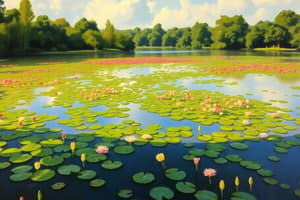Podcast
Questions and Answers
What is an ecosystem primarily composed of?
What is an ecosystem primarily composed of?
- Living organisms only
- Ecological and environmental components
- Biotic and abiotic components (correct)
- Non-living factors only
What is the primary role of producers in an ecosystem?
What is the primary role of producers in an ecosystem?
- Producing food (correct)
- Regulating the climate
- Consuming food
- Decomposing organic matter
Who is credited with coining the term 'ecosystem'?
Who is credited with coining the term 'ecosystem'?
- Albert Einstein
- Arthur Tansley (correct)
- Charles Darwin
- Gregor Mendel
What is the primary function of decomposers in an ecosystem?
What is the primary function of decomposers in an ecosystem?
What is the main characteristic of an ecosystem?
What is the main characteristic of an ecosystem?
What maintains the structure of an ecosystem?
What maintains the structure of an ecosystem?
What is the primary source of energy for almost all ecosystems?
What is the primary source of energy for almost all ecosystems?
What is the role of decomposers in an ecosystem?
What is the role of decomposers in an ecosystem?
What is the result of a disruption in an ecosystem's balance?
What is the result of a disruption in an ecosystem's balance?
What is the basis for classifying different types of ecosystems?
What is the basis for classifying different types of ecosystems?
What is the characteristic of an ecosystem that enables it to maintain its overall health and function?
What is the characteristic of an ecosystem that enables it to maintain its overall health and function?
What is the key element that supports the various trophic levels in an ecosystem?
What is the key element that supports the various trophic levels in an ecosystem?
Study Notes
What is an Ecosystem?
An ecosystem is a complex, interconnected network of living organisms and their physical environment, where they interact and rely on each other for survival. It is a unit of ecological study that examines the relationships between these biotic and abiotic components. The term "ecosystem" was first coined by the ecologist Arthur Tansley in 1935, and it has since become a fundamental concept in ecology and environmental science.
Biotic and Abiotic Components
An ecosystem is composed of two main types of components: biotic and abiotic.
Biotic Components
The biotic components of an ecosystem are the living organisms, including plants, animals, fungi, and microorganisms. These organisms interact with each other in various ways, such as through predation, competition for resources, and symbiotic relationships. The biotic components play essential roles in the ecosystem, such as producing food (producers), consuming food (consumers), and decomposing organic matter (decomposers).
Abiotic Components
Abiotic components are the non-living factors that make up the ecosystem, such as air, water, soil, and sunlight. These factors are crucial for the survival of living organisms and can influence their behavior and distribution within the ecosystem.
Energy Flow and Nutrient Cycles
The structure of an ecosystem is maintained by the flow of energy and the cycling of nutrients. The Sun provides the primary source of energy for almost all ecosystems, which is then passed through the food chain to sustain various trophic levels. Organic matter is broken down and recycled by decomposers, which release nutrients back into the ecosystem to be used by producers.
Interactions and Balance
The interactions between biotic and abiotic components in an ecosystem create a delicate balance that sustains the overall health and function of the ecosystem. This balance can be affected by various factors, such as climate change, pollution, and habitat destruction, which can lead to disruptions in the ecosystem and potentially cause ecological imbalances.
Types of Ecosystems
Ecosystems can be classified into various types based on their physical environment, such as terrestrial (forests, grasslands, tundra, and deserts) and aquatic ecosystems (lakes, rivers, and oceans). Each type of ecosystem has its own unique set of biotic and abiotic components and interactions.
In summary, an ecosystem is a dynamic, interconnected system that consists of living and non-living components, which interact and influence each other to maintain the overall balance and function of the ecosystem.
Studying That Suits You
Use AI to generate personalized quizzes and flashcards to suit your learning preferences.
Description
Learn about the complex relationships between living organisms and their physical environment in an ecosystem. Understand the biotic and abiotic components, energy flow, nutrient cycles, and interactions that maintain the balance of an ecosystem.




